Peng Dai
Sequential LLM Framework for Fashion Recommendation
Oct 15, 2024



Abstract:The fashion industry is one of the leading domains in the global e-commerce sector, prompting major online retailers to employ recommendation systems for product suggestions and customer convenience. While recommendation systems have been widely studied, most are designed for general e-commerce problems and struggle with the unique challenges of the fashion domain. To address these issues, we propose a sequential fashion recommendation framework that leverages a pre-trained large language model (LLM) enhanced with recommendation-specific prompts. Our framework employs parameter-efficient fine-tuning with extensive fashion data and introduces a novel mix-up-based retrieval technique for translating text into relevant product suggestions. Extensive experiments show our proposed framework significantly enhances fashion recommendation performance.
EMHI: A Multimodal Egocentric Human Motion Dataset with HMD and Body-Worn IMUs
Aug 30, 2024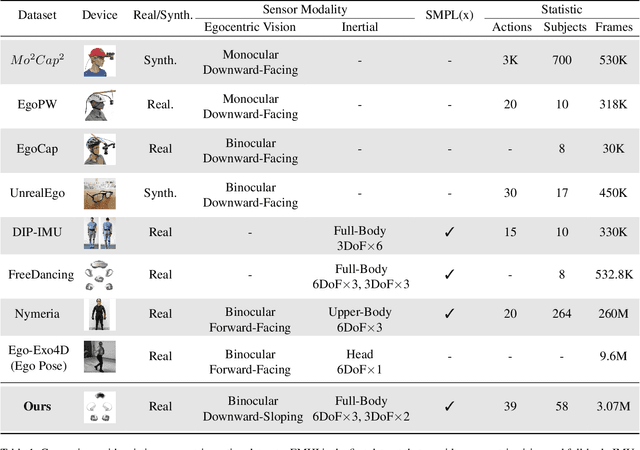
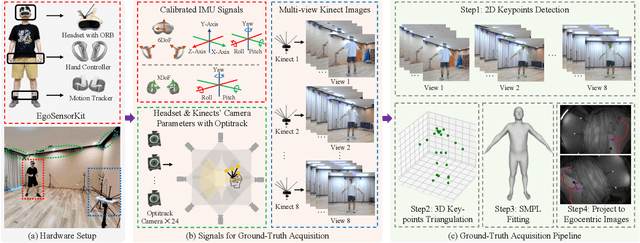


Abstract:Egocentric human pose estimation (HPE) using wearable sensors is essential for VR/AR applications. Most methods rely solely on either egocentric-view images or sparse Inertial Measurement Unit (IMU) signals, leading to inaccuracies due to self-occlusion in images or the sparseness and drift of inertial sensors. Most importantly, the lack of real-world datasets containing both modalities is a major obstacle to progress in this field. To overcome the barrier, we propose EMHI, a multimodal \textbf{E}gocentric human \textbf{M}otion dataset with \textbf{H}ead-Mounted Display (HMD) and body-worn \textbf{I}MUs, with all data collected under the real VR product suite. Specifically, EMHI provides synchronized stereo images from downward-sloping cameras on the headset and IMU data from body-worn sensors, along with pose annotations in SMPL format. This dataset consists of 885 sequences captured by 58 subjects performing 39 actions, totaling about 28.5 hours of recording. We evaluate the annotations by comparing them with optical marker-based SMPL fitting results. To substantiate the reliability of our dataset, we introduce MEPoser, a new baseline method for multimodal egocentric HPE, which employs a multimodal fusion encoder, temporal feature encoder, and MLP-based regression heads. The experiments on EMHI show that MEPoser outperforms existing single-modal methods and demonstrates the value of our dataset in solving the problem of egocentric HPE. We believe the release of EMHI and the method could advance the research of egocentric HPE and expedite the practical implementation of this technology in VR/AR products.
TexGen: Text-Guided 3D Texture Generation with Multi-view Sampling and Resampling
Aug 02, 2024Abstract:Given a 3D mesh, we aim to synthesize 3D textures that correspond to arbitrary textual descriptions. Current methods for generating and assembling textures from sampled views often result in prominent seams or excessive smoothing. To tackle these issues, we present TexGen, a novel multi-view sampling and resampling framework for texture generation leveraging a pre-trained text-to-image diffusion model. For view consistent sampling, first of all we maintain a texture map in RGB space that is parameterized by the denoising step and updated after each sampling step of the diffusion model to progressively reduce the view discrepancy. An attention-guided multi-view sampling strategy is exploited to broadcast the appearance information across views. To preserve texture details, we develop a noise resampling technique that aids in the estimation of noise, generating inputs for subsequent denoising steps, as directed by the text prompt and current texture map. Through an extensive amount of qualitative and quantitative evaluations, we demonstrate that our proposed method produces significantly better texture quality for diverse 3D objects with a high degree of view consistency and rich appearance details, outperforming current state-of-the-art methods. Furthermore, our proposed texture generation technique can also be applied to texture editing while preserving the original identity. More experimental results are available at https://dong-huo.github.io/TexGen/
GSD: View-Guided Gaussian Splatting Diffusion for 3D Reconstruction
Jul 05, 2024Abstract:We present GSD, a diffusion model approach based on Gaussian Splatting (GS) representation for 3D object reconstruction from a single view. Prior works suffer from inconsistent 3D geometry or mediocre rendering quality due to improper representations. We take a step towards resolving these shortcomings by utilizing the recent state-of-the-art 3D explicit representation, Gaussian Splatting, and an unconditional diffusion model. This model learns to generate 3D objects represented by sets of GS ellipsoids. With these strong generative 3D priors, though learning unconditionally, the diffusion model is ready for view-guided reconstruction without further model fine-tuning. This is achieved by propagating fine-grained 2D features through the efficient yet flexible splatting function and the guided denoising sampling process. In addition, a 2D diffusion model is further employed to enhance rendering fidelity, and improve reconstructed GS quality by polishing and re-using the rendered images. The final reconstructed objects explicitly come with high-quality 3D structure and texture, and can be efficiently rendered in arbitrary views. Experiments on the challenging real-world CO3D dataset demonstrate the superiority of our approach.
SVG: 3D Stereoscopic Video Generation via Denoising Frame Matrix
Jun 29, 2024Abstract:Video generation models have demonstrated great capabilities of producing impressive monocular videos, however, the generation of 3D stereoscopic video remains under-explored. We propose a pose-free and training-free approach for generating 3D stereoscopic videos using an off-the-shelf monocular video generation model. Our method warps a generated monocular video into camera views on stereoscopic baseline using estimated video depth, and employs a novel frame matrix video inpainting framework. The framework leverages the video generation model to inpaint frames observed from different timestamps and views. This effective approach generates consistent and semantically coherent stereoscopic videos without scene optimization or model fine-tuning. Moreover, we develop a disocclusion boundary re-injection scheme that further improves the quality of video inpainting by alleviating the negative effects propagated from disoccluded areas in the latent space. We validate the efficacy of our proposed method by conducting experiments on videos from various generative models, including Sora [4 ], Lumiere [2], WALT [8 ], and Zeroscope [ 42]. The experiments demonstrate that our method has a significant improvement over previous methods. The code will be released at \url{https://daipengwa.github.io/SVG_ProjectPage}.
EIVEN: Efficient Implicit Attribute Value Extraction using Multimodal LLM
Apr 13, 2024Abstract:In e-commerce, accurately extracting product attribute values from multimodal data is crucial for improving user experience and operational efficiency of retailers. However, previous approaches to multimodal attribute value extraction often struggle with implicit attribute values embedded in images or text, rely heavily on extensive labeled data, and can easily confuse similar attribute values. To address these issues, we introduce EIVEN, a data- and parameter-efficient generative framework that pioneers the use of multimodal LLM for implicit attribute value extraction. EIVEN leverages the rich inherent knowledge of a pre-trained LLM and vision encoder to reduce reliance on labeled data. We also introduce a novel Learning-by-Comparison technique to reduce model confusion by enforcing attribute value comparison and difference identification. Additionally, we construct initial open-source datasets for multimodal implicit attribute value extraction. Our extensive experiments reveal that EIVEN significantly outperforms existing methods in extracting implicit attribute values while requiring less labeled data.
Total-Decom: Decomposed 3D Scene Reconstruction with Minimal Interaction
Mar 30, 2024
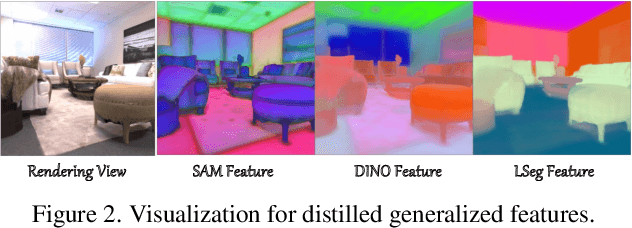
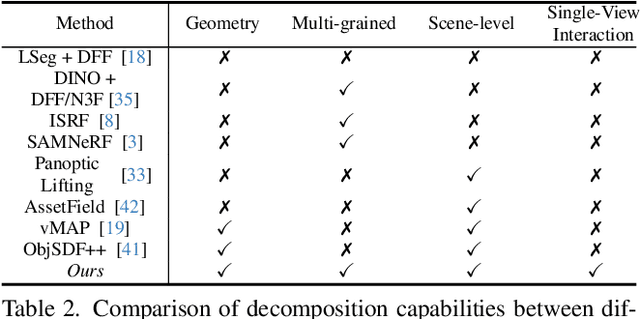

Abstract:Scene reconstruction from multi-view images is a fundamental problem in computer vision and graphics. Recent neural implicit surface reconstruction methods have achieved high-quality results; however, editing and manipulating the 3D geometry of reconstructed scenes remains challenging due to the absence of naturally decomposed object entities and complex object/background compositions. In this paper, we present Total-Decom, a novel method for decomposed 3D reconstruction with minimal human interaction. Our approach seamlessly integrates the Segment Anything Model (SAM) with hybrid implicit-explicit neural surface representations and a mesh-based region-growing technique for accurate 3D object decomposition. Total-Decom requires minimal human annotations while providing users with real-time control over the granularity and quality of decomposition. We extensively evaluate our method on benchmark datasets and demonstrate its potential for downstream applications, such as animation and scene editing. The code is available at https://github.com/CVMI-Lab/Total-Decom.git.
HMD-Poser: On-Device Real-time Human Motion Tracking from Scalable Sparse Observations
Mar 06, 2024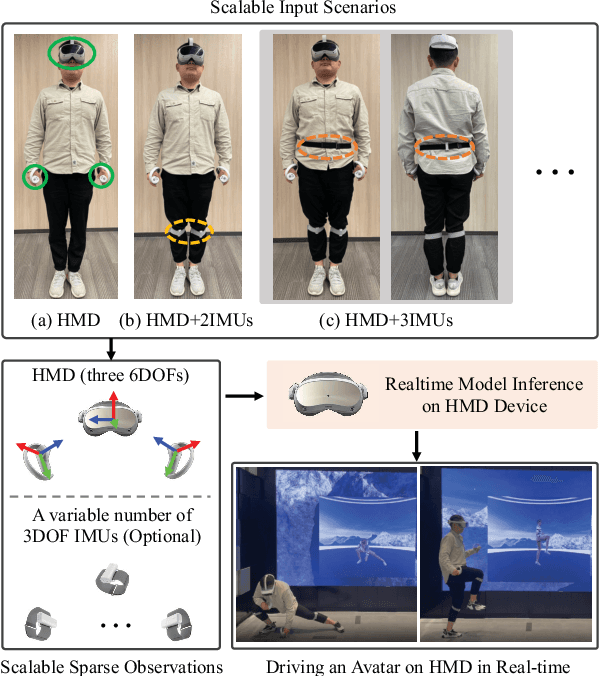

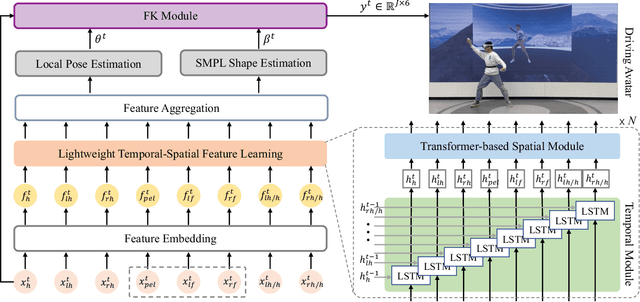

Abstract:It is especially challenging to achieve real-time human motion tracking on a standalone VR Head-Mounted Display (HMD) such as Meta Quest and PICO. In this paper, we propose HMD-Poser, the first unified approach to recover full-body motions using scalable sparse observations from HMD and body-worn IMUs. In particular, it can support a variety of input scenarios, such as HMD, HMD+2IMUs, HMD+3IMUs, etc. The scalability of inputs may accommodate users' choices for both high tracking accuracy and easy-to-wear. A lightweight temporal-spatial feature learning network is proposed in HMD-Poser to guarantee that the model runs in real-time on HMDs. Furthermore, HMD-Poser presents online body shape estimation to improve the position accuracy of body joints. Extensive experimental results on the challenging AMASS dataset show that HMD-Poser achieves new state-of-the-art results in both accuracy and real-time performance. We also build a new free-dancing motion dataset to evaluate HMD-Poser's on-device performance and investigate the performance gap between synthetic data and real-captured sensor data. Finally, we demonstrate our HMD-Poser with a real-time Avatar-driving application on a commercial HMD. Our code and free-dancing motion dataset are available https://pico-ai-team.github.io/hmd-poser
Generative Human Motion Stylization in Latent Space
Jan 24, 2024Abstract:Human motion stylization aims to revise the style of an input motion while keeping its content unaltered. Unlike existing works that operate directly in pose space, we leverage the latent space of pretrained autoencoders as a more expressive and robust representation for motion extraction and infusion. Building upon this, we present a novel generative model that produces diverse stylization results of a single motion (latent) code. During training, a motion code is decomposed into two coding components: a deterministic content code, and a probabilistic style code adhering to a prior distribution; then a generator massages the random combination of content and style codes to reconstruct the corresponding motion codes. Our approach is versatile, allowing the learning of probabilistic style space from either style labeled or unlabeled motions, providing notable flexibility in stylization as well. In inference, users can opt to stylize a motion using style cues from a reference motion or a label. Even in the absence of explicit style input, our model facilitates novel re-stylization by sampling from the unconditional style prior distribution. Experimental results show that our proposed stylization models, despite their lightweight design, outperform the state-of-the-arts in style reeanactment, content preservation, and generalization across various applications and settings. Project Page: https://yxmu.foo/GenMoStyle
GO-NeRF: Generating Virtual Objects in Neural Radiance Fields
Jan 11, 2024Abstract:Despite advances in 3D generation, the direct creation of 3D objects within an existing 3D scene represented as NeRF remains underexplored. This process requires not only high-quality 3D object generation but also seamless composition of the generated 3D content into the existing NeRF. To this end, we propose a new method, GO-NeRF, capable of utilizing scene context for high-quality and harmonious 3D object generation within an existing NeRF. Our method employs a compositional rendering formulation that allows the generated 3D objects to be seamlessly composited into the scene utilizing learned 3D-aware opacity maps without introducing unintended scene modification. Moreover, we also develop tailored optimization objectives and training strategies to enhance the model's ability to exploit scene context and mitigate artifacts, such as floaters, originating from 3D object generation within a scene. Extensive experiments on both feed-forward and $360^o$ scenes show the superior performance of our proposed GO-NeRF in generating objects harmoniously composited with surrounding scenes and synthesizing high-quality novel view images. Project page at {\url{https://daipengwa.github.io/GO-NeRF/}.
 Add to Chrome
Add to Chrome Add to Firefox
Add to Firefox Add to Edge
Add to Edge